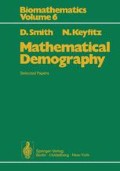Abstract
The requirements Parlett introduces for stability of non-negative matrices, irreducibility and primitivity, have an intuitive base. Irreducibility translates as the restriction that the projection matrix be for a single population, as in the continuous form of the renewal equation. (Matrix techniques for extracting stable roots and vectors do not apply to non-interacting populations; nor in general would such populations have the same roots.)
From Theoretical Population Biology 1. Excerpts are from pages 191–202.
Access this chapter
Tax calculation will be finalised at checkout
Purchases are for personal use only
Preview
Unable to display preview. Download preview PDF.
References
Dulmage, A. L. and Mendelsohn, N. S. 1964. Gaps in the exponent set of primitive matrices, Illinois J. Math. 8, 642–656.
Heap, B. R. AND Lynn, M. S. 1964. The index of primitivity of a non-negative matrix, Numer. Math. 6, 120–144.
Heap, B. R. AND Lynn, M. S. 1964. A Graph-theoretic algorithm for the solution of a linear diophantine problem of Frobenius, Numer. Math. 6, 346–354.
Heap, B. R. AND Lynn, M. S. 1965. On a linear diophantine problem of Frobenius: An improved algorithm, Numer. Math. 7, 226–231.
Keyfitz, N. 1968. “Introduction to the Mathematics of Population,” Addison-Wesley Publ. Co., Reading, Mass.
Mcfarland, D. D. 1969. On the theory of stable populations. A new and elementary proof of the theorems under weaker assumptions, Demography 6, 303–322.
Rosenblatt, D. 1957. On the graphs and asymptotic forms of finite Boolean relation matrices and stochastic matrices, Naval Res. Logist. Quart. 4, 151–167.
SYKES, Z. M. 1969. On discrete stable population theory, Biometrics 25.
Marcus, M. AND Minc, H. 1964. “A Survey of Matrix Theory and Matrix Inequalities,” Allyn and Bacon, Inc., Boston, Mass.
Gartmacher, F. R. 1959. “Theory of Matrices,” Vol. 2, Chelsea, New York.
Karlin, —. 1966. “A First Course in Stochastic Processes,” Academic Press, Inc., New York.
Lopez, A. 1961. “Problems in Stable Population Theory,” Office of Population Research, Princeton, N. J.
Berge, C. 1962. “The Theory of Graphs,” Methuen, London.
Rights and permissions
Copyright information
© 1977 Springer-Verlag Berlin · Heidelberg
About this chapter
Cite this chapter
Parlett, B. (1977). Ergodic Properties of Population I: The One Sex Model. In: Mathematical Demography. Biomathematics, vol 6. Springer, Berlin, Heidelberg. https://doi.org/10.1007/978-3-642-81046-6_29
Download citation
DOI: https://doi.org/10.1007/978-3-642-81046-6_29
Publisher Name: Springer, Berlin, Heidelberg
Print ISBN: 978-3-642-81048-0
Online ISBN: 978-3-642-81046-6
eBook Packages: Springer Book Archive

